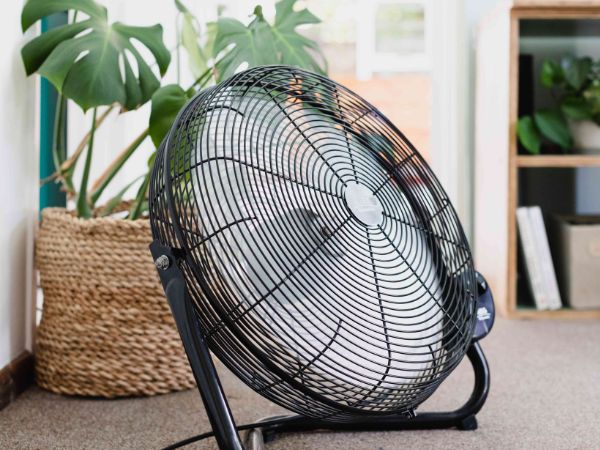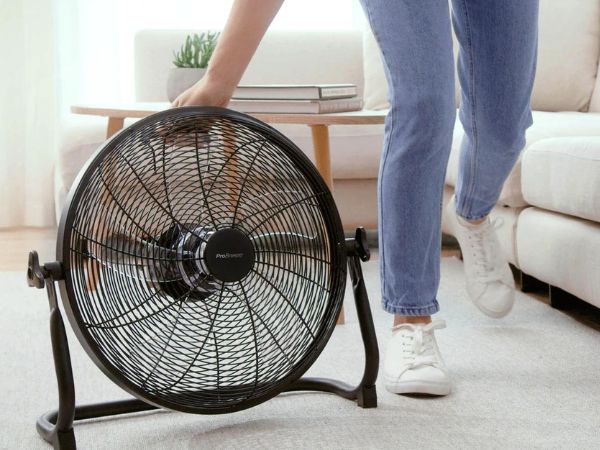How To Position Fans To Cool A Room With AC?

When it comes to cooling a room with air conditioning (AC), the positioning of fans plays a crucial role in maximizing the effectiveness of the cooling system. Fans can enhance air circulation, improve ventilation, and help distribute cool air throughout the room. By strategically placing fans, you can create a comfortable and refreshing environment even during the hottest days. In this article, we will explore various fan placement techniques and provide practical tips on how to position fans to cool a room with ac.
Contents
- 1 Assessing the Room: Evaluating the Size and Layout for Optimal Fan Positioning
- 2 Understanding Air Circulation: How Fans Can Enhance the Effectiveness of Air Conditioning
- 3 Fan Types and Their Benefits: Exploring Different Fan Options for Cooling a Room
- 4 Determining the Ideal Fan Locations: Identifying Key Areas for Maximum Cooling Efficiency
- 5 Placement Near Windows: Utilizing Fans to Maximize Airflow from Outside
- 6 Positioning Fans Near Vents: Enhancing Air Distribution from the Air Conditioning System
- 7 Utilizing Ceiling Fans: Harnessing the Power of Overhead Circulation
- 8 Strategic Positioning for Cross-Ventilation: Creating a Natural Cooling Effect with Fans
- 9 Angling Fans for Directional Airflow: Directing Cool Air towards Specific Areas in the Room
- 10 Avoiding Obstacles: Placing Fans to Minimize Airflow Obstructions
- 11 Using Oscillating Fans: Enhancing Air Movement in Larger Spaces
- 12 Creating a Fan Network: Combining Multiple Fans for Comprehensive Cooling
- 13 Enhancing Fan Effectiveness with Curtains and Blinds: Controlling Sunlight and Heat
- 14 Utilizing Fan Speed and Direction Settings: Optimizing Cooling Efficiency
- 15 Adjusting Fan Height: Targeting Different Levels of Air Circulation
- 16 Maintaining Proper Fan Maintenance: Cleaning and Servicing for Optimal Performance
- 17 Energy-Saving Considerations: Balancing AC Usage with Fan Utilization
- 18 Conclusion: Achieving the Perfect Balance of AC and Fan Placement for a Cool and Comfortable Room
- 19 FAQs (How To Position Fans To Cool A Room With AC)
Assessing the Room: Evaluating the Size and Layout for Optimal Fan Positioning
Before placing fans in your room, it is essential to assess the size and layout of the space. A larger room may require multiple fans, while a smaller room might need just one. Consider the room’s dimensions, the presence of furniture, and any potential obstacles that could obstruct the airflow. By evaluating these factors, you can determine the number and type of fans needed to effectively cool the room.
Understanding Air Circulation: How Fans Can Enhance the Effectiveness of Air Conditioning
Fans are not a substitute for air conditioning, but they can significantly enhance its performance. Air conditioning cools the air, but fans help distribute that cool air more efficiently, creating a more even temperature throughout the room. By improving air circulation, fans assist the AC unit in removing heat and humidity from the space. This collaboration between AC and fans results in a cooler and more comfortable environment.
Auto Amazon Links: No products found. No products found. http_request_failed: A valid URL was not provided. URL: https://ws-na.amazon-adsystem.com/widgets/q?SearchIndex=All&multipageStart=0&multipageCount=20&Operation=GetResults&Keywords=How+can+I+cool+my+room+faster+with+AC+and+fan%3F|Home+appliances|Do+fans+cool+a+room+with+AC%3F|How+To+Position+Fans+To+Cool+A+Room+With+AC|SAMSUNG+Galaxy+S23+Ultra+Cell+Phone&InstanceId=0&TemplateId=MobileSearchResults&ServiceVersion=20070822&MarketPlace=US Cache: AAL_443ea5a3867fcbb263a7e306ce92e450

Fan Types and Their Benefits: Exploring Different Fan Options for Cooling a Room
There are various types of fans available, each with its own benefits for cooling a room. Ceiling fans are ideal for larger spaces as they can create a gentle breeze throughout the entire room. Table fans and floor fans are portable and versatile, allowing you to direct airflow precisely where it is needed. Tower fans are tall and slim, providing widespread cooling with their oscillating feature. Choose the fan type that suits your room size, layout, and personal preferences to optimize its cooling capabilities.
Determining the Ideal Fan Locations: Identifying Key Areas for Maximum Cooling Efficiency
To achieve maximum cooling efficiency, it is crucial to position fans in strategic locations. Start by placing a fan near the window to draw in fresh air from outside. This technique can work wonders during cooler evenings or in areas with a pleasant outdoor breeze. Additionally, positioning fans near vents can help enhance air distribution from the AC system, ensuring that cool air reaches all corners of the room effectively.
Placement Near Windows: Utilizing Fans to Maximize Airflow from Outside
Fans can be positioned strategically near windows to maximize the airflow from outside. By placing a fan facing inward, you can draw in cooler air from the outside and circulate it throughout the room. This technique is particularly effective during the early morning or late evening when the outside temperature is lower.
Positioning Fans Near Vents: Enhancing Air Distribution from the Air Conditioning System
To optimize the performance of your air conditioning system, consider placing fans near vents. By doing so, you can help distribute the cool air more effectively throughout the room. The fans will assist in pushing the cooled air into different areas, ensuring a more uniform temperature and eliminating any hot spots.

Utilizing Ceiling Fans: Harnessing the Power of Overhead Circulation
Ceiling fans are a valuable addition to any room with air conditioning. They create a gentle breeze that helps circulate cool air from the AC unit. By running the ceiling fan in the counterclockwise direction during the summer, you can create a downward airflow that provides a cooling effect. The combination of AC and ceiling fans can help reduce the reliance on the AC unit and enhance overall comfort.
Strategic Positioning for Cross-Ventilation: Creating a Natural Cooling Effect with Fans
Cross-ventilation is a natural and effective way to cool a room. By strategically positioning fans in different areas of the room, you can create a flow of air that moves from one side to the other. Place one fan near a window or doorway to draw in fresh air, and position another fan on the opposite side to push the warm air out. This technique utilizes the natural breeze and promotes air exchange, resulting in a cooler and more pleasant indoor environment.
Auto Amazon Links: No products found. No products found. http_request_failed: A valid URL was not provided. URL: https://ws-na.amazon-adsystem.com/widgets/q?SearchIndex=All&multipageStart=0&multipageCount=20&Operation=GetResults&Keywords=How+to+position+fan+with+air+conditioner%3F|Do+fans+cool+a+room+with+AC%3F|Galaxy+s23|How+can+I+cool+my+room+faster+with+AC+and+fan%3F|SAMSUNG+Galaxy+S23+Ultra+Cell+Phone&InstanceId=0&TemplateId=MobileSearchResults&ServiceVersion=20070822&MarketPlace=US Cache: AAL_9bcb4db3b5bf13c05ef65ee9293e6b1a
Angling Fans for Directional Airflow: Directing Cool Air towards Specific Areas in the Room
In certain situations, you may want to direct the cool air from a fan towards specific areas in the room. By angling the fan slightly upward, you can create an upward breeze that helps cool the ceiling and walls. Conversely, angling the fan downward can create a more direct cooling effect on people or specific objects. Experiment with different angles to find the optimal airflow direction for your comfort.
Avoiding Obstacles: Placing Fans to Minimize Airflow Obstructions
When positioning fans, it is essential to consider potential obstacles that could obstruct the airflow. Make sure the fan’s path is clear of furniture, curtains, or any other objects that could impede the air circulation. By avoiding obstacles, you can ensure that the fan operates at its maximum efficiency, providing an uninterrupted flow of cool air.

Using Oscillating Fans: Enhancing Air Movement in Larger Spaces
Oscillating fans are a great choice for larger rooms as they provide wider coverage. These fans rotate from side to side, effectively moving air throughout the space. By placing an oscillating fan in a central location, you can achieve better air circulation and maintain a consistent temperature in the room.
Creating a Fan Network: Combining Multiple Fans for Comprehensive Cooling
In some cases, a single fan may not be sufficient to cool an entire room. By combining multiple fans strategically, you can create a fan network that covers the entire space. Position fans in different corners, angles, or levels to create a comprehensive cooling effect. Experiment with various fan placements to achieve the desired airflow and temperature distribution.
Enhancing Fan Effectiveness with Curtains and Blinds: Controlling Sunlight and Heat
Curtains and blinds are not only useful for privacy and light control but also for enhancing the effectiveness of fans. During the daytime, close curtains or blinds to block out sunlight and heat. This will prevent the room from heating up, reducing the workload on the AC unit and fans. In the evening or at night, open the curtains to allow cool air from outside to enter the room and be circulated by the fans.
Utilizing Fan Speed and Direction Settings: Optimizing Cooling Efficiency
Most fans offer speed and direction settings that can be adjusted according to your cooling needs. In hotter conditions, set the fan to a higher speed for a stronger breeze. During milder temperatures, a lower speed can suffice to maintain a comfortable atmosphere. Additionally, experiment with different fan directions, such as oscillating or targeted airflow, to find the most effective cooling method for your room.

Adjusting Fan Height: Targeting Different Levels of Air Circulation
The height at which you place a fan can impact its cooling capabilities. Higher placements can help cool the upper part of the room, while lower placements target the lower areas. Experiment with different fan heights to achieve the desired balance of airflow and temperature distribution throughout the room.
Maintaining Proper Fan Maintenance: Cleaning and Servicing for Optimal Performance
To ensure the optimal performance of your fans, regular maintenance is crucial. Dust and dirt can accumulate on fan blades, reducing their efficiency. Clean the blades and grilles periodically using a soft brush or cloth to remove any buildup. Additionally, check and tighten any loose screws or connections. Proper maintenance will keep your fans running smoothly and effectively, providing optimal cooling performance.
Energy-Saving Considerations: Balancing AC Usage with Fan Utilization
While fans are energy-efficient, it is important to balance their usage with the air conditioning system. Fans can help circulate and distribute cool air, reducing the reliance on the AC unit and potentially saving energy. Use fans as the primary cooling method during mild temperatures and only turn on the AC when necessary. By finding the right balance between fans and AC usage, you can minimize energy consumption while maintaining a comfortable environment.
Conclusion: Achieving the Perfect Balance of AC and Fan Placement for a Cool and Comfortable Room
Proper fan placement is essential for effectively cooling a room with air conditioning. By strategically positioning fans near windows, vents, and in cross-ventilation configurations, you can enhance air circulation and distribute cool air efficiently. Utilizing different fan types, adjusting fan speed and direction, and combining multiple fans can further optimize cooling performance. Remember to maintain the fans regularly and consider energy-saving practices. By achieving the perfect balance between AC and fan utilization, you can create a cool and comfortable environment to beat the heat.
FAQs (How To Position Fans To Cool A Room With AC)
Q1. Can I use a fan without air conditioning to cool a room effectively?
Yes, fans can provide a cooling effect by circulating the air and creating a breeze. While they may not lower the temperature like air conditioning, fans can make you feel more comfortable by evaporating moisture from your skin, resulting in a perceived cooling sensation. However, in extremely hot conditions, fans alone may not be sufficient, and air conditioning might be necessary to achieve a significant cooling effect.
Q2. How many fans do I need for a medium-sized room?
The number of fans needed for a medium-sized room depends on various factors such as room layout, ceiling height, and personal preference. In general, one or two fans should be sufficient to provide adequate airflow and cooling. Consider placing fans strategically in different areas to ensure proper air circulation throughout the room.
Q3. Is it necessary to use ceiling fans if I already have air conditioning?
Using ceiling fans in conjunction with air conditioning can be beneficial. Ceiling fans create a gentle breeze that enhances air circulation, helping the cool air from the air conditioning system reach every corner of the room. This allows you to set the air conditioner at a slightly higher temperature while still feeling comfortable due to the airflow generated by the ceiling fan.
Q4. Can I use fans to cool multiple rooms simultaneously?
Yes, fans can be used to cool multiple rooms simultaneously by strategically placing them to create a cross-ventilation effect. Position fans in a way that facilitates the movement of air from one room to another, such as placing a fan in front of an open doorway or window to draw in fresh air while another fan pushes the warm air out. This technique helps create a flow of air between rooms and can effectively cool multiple areas.








